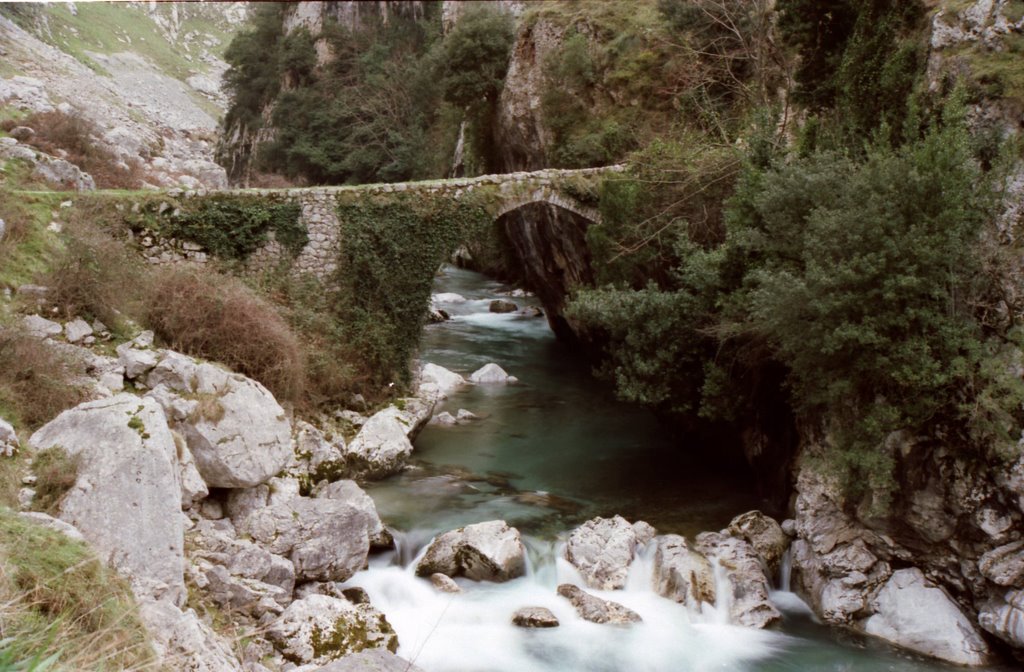Juan Pablo García-Arias. Alumno ETSI Caminos. UPM.

Foto 1. Bridge of the Jaya. Upstream view. (Arrizabalga, E. (s.f.)
“Near the Morjosa, a modest stone bridge flown over the Cares is presented to our view; it is Poncebos, which we cross without hesitation because Nature is so great there that it attracts us as it attracts the precipice without thinking about ephemeral life”. (Small Days, José Saro y Rojas).
Located west of the Principality of Asturias, this small bridge is located over the Cares River at 262 M.S.N.M. and it is the only one that gives access to Bulnes, from the Cabrales council; the last town in the Spanish geography that lacks road access and, furthermore, is, until today, the only connection between the central massif and the western one of the Picos de Europa, through the GR – 202 road, also known as “Ruta de the Reconquista ”, which unites, in a 109 km stretch of length, Covadonga, parish of the council of Cangas de Onís (Principality of Asturias), with the locality of Cosgaya, which is the municipal term of Camaleño, already in the Cantabrian Autonomous Community.
Following the course of the Cares River 15 k.m. further down, outside the Picos de Europa National Park, is another bridge with similar characteristics, Puente de la Vidre, in the town of Trescares in the Asturian council of Peñamellera Alta. It was built in the late Middle Ages on the remains of one from the High Roman Empire that is linked to the Roman road built by Agrippa going up the riverbed of the Deva and the Cares. It has a single arch that supports its pillars on rocky massifs on both banks of the river. The presence of this second bridge will be very useful to us in the dating of the study subject.
On the other hand, the bridge of La Jaya is not dated, nor does it have on either of its two faces marks, stonemason or any other kind, that help us to locate it temporarily, even roughly, in a first attempt at dating. However, a first approximation would date it, at the latest, to the Visigothic period, since there is a popular tradition that it served as a passage for D. Pelayo in the year 718 AD. in the pursuit of the Valí of the northwestern third of the Iberian Peninsula Otman ben Neza.
However, taking into account that there is no news of civil engineering work carried out in the Visigoth period and of locating itself in an orography with little Spanish-Visigothic presence, we conclude as it does, thanks to the collaboration of Professor Dña. May Vila Beltran de Heredia, graduated in art history from the Complutense University of Madrid, that the construction of this bridge could well be from Roman times and after 19 BC, as can be seen at its base, although it should have been restored, repaired or completed during the Middle Ages, as indicated by the pointed arch that stars in the construction.

Foto 2. Bridge of the Jaya. Downstream view. Unknown author. (24 de Diciembre de 2015).
The bridge is built in limestone extracted from the mountains that surround it, with a characteristic grayish color that makes it blend in perfectly with the surrounding landscape, thus making it seem to come out of the rock itself on the left bank of the river. , believing itself an extension of the highest peaks of the Picos de Europa, inviting us to cross from massif to massif, to explore every corner, fountain or cave of the National Park. Between the joints of the construction, the ivy and different wild vegetables find a small place to take root, which helps to understand this discreet work as an extension of the geographical framework in which it stands.
The modest roads and the humility of life in the towns that settle in the vicinity of the bridge, make us imagine that the such wise choice of materials is due to the proximity and ease of finding them in the vicinity. Due to the limestone nature of the Park, and the erosion by karstification and gelling so characteristic of the place, the extraction of materials for the construction of the bridge should not have been technically complicated, and perhaps that is why the restoration could be carried out. centuries after the initial uprising, already during the Middle Ages.
Not only the adaptation, but the mimicry of the Jaya bridge with the environment is spectacular. Only time can make the vegetation give life to the bridge, only such a colossal orography is capable of hiding this work in its entrails, only the magnificence of the Park is capable of leaving so much synchrony between the most modest civil engineering of our history and an untamed nature that overwhelms the observer.
